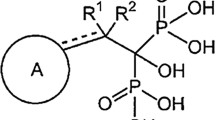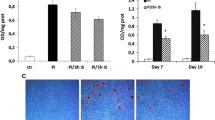Abstract
Patients with chronic kidney disease develop vascular calcification, owing to impaired calcium and phosphate metabolism. The prevention of vascular calcification is important to improve the prognosis of such patients. In this study, we investigated whether treatment with FYB-931, a novel bisphosphonate compound, prevents vascular calcification in rat aortic rings cultured in high-phosphate medium for 9 days, assessed by measurement of the calcium content and the degree of calcium deposition, visualized using von Kossa staining. The effect on the transformation of calciprotein particles (CPPs) from primary to secondary CPPs was assessed using a fluorescent probe-based flow cytometric assay. FYB-931 dose-dependently prevented high phosphate-induced aortic calcification, but failed to rapidly cause the regression of high phosphate-induced vascular calcification once it had developed. Furthermore, the treatment dose-dependently inhibited the high phosphate-induced transformation from primary to secondary CPPs. In addition, the treatment with FYB-931 prevented the transformation from primary to secondary CPPs in vitamin D3-treated rats as a model of ectopic calcification, consistent with the results from rat aortic rings. In conclusion, treatment with FYB-931 prevents high phosphate-induced rat aortic vascular calcification by altering the dynamics of CPP transformation. This finding suggests that inhibition of the transformation from primary to secondary CPPs is an important target for the prevention of vascular calcification in patients with chronic kidney disease.





Similar content being viewed by others
References
Herzog CA, Asinger RW, Berger AK et al (2011) Cardiovascular disease in chronic kidney disease. A clinical update from kidney disease: improving global outcomes (KDIGO). Kidney Int 80:572–586. https://doi.org/10.1038/ki.2011.223
Ohya M, Otani H, Kimura K et al (2011) Vascular calcification estimated by aortic calcification area index is significant predictive parameter of cardiovascular mortality in hemodialysis patients. Clin Exp Nephrol 15:877–883. https://doi.org/10.1007/s10157-011-0517-y
Chen J, Budoff MJ, Reilly MP et al (2017) Coronary artery calcification and risk of cardiovascular disease and death among patients with chronic kidney disease. JAMA Cardiol 2:635–643. https://doi.org/10.1001/jamacardio.2017.0363
GBD Chronic Kidney Disease Collaboration (2020) Global, regional, and national burden of chronic kidney disease, 1990–2017: a systematic analysis for the global burden of Disease Study 2017. Lancet 395:709–733. https://doi.org/10.1016/S0140-6736(20)30045-3
Gonçalves FB, Voûte MT, Hoeks SE et al (2012) Calcification of the abdominal aorta as an independent predictor of cardiovascular events: a meta-analysis. Heart 98:988–994. https://doi.org/10.1136/heartjnl-2011-301464
Yano Y, O’Donnell CJ, Kuller L et al (2017) Association of coronary artery calcium score vs. age with cardiovascular risk in older adults: an analysis of pooled population-based studies. JAMA Cardiol 2:986–994. https://doi.org/10.1001/jamacardio.2017.2498
Sprague SM, Martin KJ, Coyne DW (2021) Phosphate balance and CKD-mineral bone disease. Kidney Int Rep 6:2049–2058. https://doi.org/10.1016/j.ekir.2021.05.012
Shigematsu T, Sonou T, Ohya M et al (2017) Preventive strategies for vascular calcification in patients with chronic kidney disease. Contrib Nephrol 189:169–177. https://doi.org/10.1159/000452310
Doshi SM, Wish JB (2022) Past, present, and future of phosphate management. Kidney Int Rep 7:688–698. https://doi.org/10.1016/j.ekir.2022.01.1055
Xu C, Smith ER, Tiong MK et al (2022) Interventions to attenuate vascular calcification progression in chronic kidney disease: a systematic review of clinical trials. J Am Soc Nephrol 33:1011–1032. https://doi.org/10.1681/ASN.2021101327
Arnold A, Dennison E, Kovacs CS et al (2021) Hormonal regulation of biomineralization. Nat Rev Endocrinol 17:261–275. https://doi.org/10.1038/s41574-021-00477-2
Kuro-O M (2021) Klotho and calciprotein particles as therapeutic targets against accelerated ageing. Clin Sci (Lond) 135:1915–1927. https://doi.org/10.1042/CS20201453
Paloian NJ, Giachelli CM (2014) A current understanding of vascular calcification in CKD. Am J Physiol Renal Physiol 307:F891-900. https://doi.org/10.1152/ajprenal.00163.2014
Aghagolzadeh P, Bachtler M, Bijarnia R et al (2016) Calcification of vascular smooth muscle cells is induced by secondary calciprotein particles and enhanced by tumor necrosis factor-α. Atherosclerosis 251:404–414. https://doi.org/10.1016/j.atherosclerosis.2016.05.044
Ter Braake AD, Eelderink C, Zeper LW et al (2020) Calciprotein particle inhibition explains magnesium-mediated protection against vascular calcification. Nephrol Dial Transplant 35:765–773. https://doi.org/10.1093/ndt/gfz190
Chen W, Anokhina V, Dieudonne G et al (2019) Patients with advanced chronic kidney disease and vascular calcification have a large hydrodynamic radius of secondary calciprotein particles. Nephrol Dial Transplant 34:992–1000. https://doi.org/10.1093/ndt/gfy117
Russel R, Graham G (2011) Bisphosphonates: the first 40 years. Bone 49:2–19. https://doi.org/10.1016/j.bone.2011.04.022
Price PA, Faus SA, Williamson MK (2001) Bisphosphonates alendronate and ibandronate inhibit artery calcification at doses comparable to those that inhibit bone resorption. Arterioscler Thromb Vasc Biol 21:817–824. https://doi.org/10.1161/01.atv.21.5.817
Price PA, Roublick AM, Williamson MK (2006) Artery calcification in uremic rats is increased by a low protein diet and prevented by treatment with ibandronate. Kidney Int 70:1577–1583. https://doi.org/10.1038/sj.ki.5001841
Lomashvili KA, Monier-Faugere MC, Wang X et al (2009) Effect of bisphosphonates on vascular calcification and bone metabolism in experimental renal failure. Kidney Int 75:617–625. https://doi.org/10.1038/ki.2008.646
Nitta K, Akiba T, Suzuki K et al (2004) Effects of cyclic intermittent etidronate therapy on coronary artery calcification in patients receiving long-term hemodialysis. Am J Kidney Dis 44:680–688. https://doi.org/10.1053/j.ajkd.2004.06.009
Hashiba H, Aizawa S, Tamura K et al (2004) Inhibitory effects of etidronate on the progression of vascular calcification in hemodialysis patients. Ther Apher Dial 8:241–247. https://doi.org/10.1111/j.1526-0968.2004.00136.x
Toussaint ND, Lau KK, Strauss BJ et al (2010) Effect of alendronate on vascular calcification in CKD stages 3 and 4: a pilot randomized controlled trial. Am J Kidney Dis 56:57–68. https://doi.org/10.1053/j.ajkd.2009.12.039
Hartle JE, Tang X, Kirchner HL et al (2012) Bisphosphonate therapy, death, and cardiovascular events among female patients with CKD: a retrospective cohort study. Am J Kidney Dis 59:636–644. https://doi.org/10.1053/j.ajkd.2011.11.037
Ishida K, Ashizawa N, Matsumoto K et al (2019) Novel bisphosphonate compound FYB-931 preferentially inhibits aortic calcification in vitamin D3-treated rats. J Bone Miner Metab 37:796–804. https://doi.org/10.1007/s00774-019-00987-0
Cutini PH, Rauschemberger MB, Sandoval MJ, Massheimer VL (2016) Vascular action of bisphosphonates: in vitro effect of alendronate on the regulation of cellular events involved in vessel pathogenesis. J Mol Cell Cardiol 100:83–92. https://doi.org/10.1016/j.yjmcc.2016.08.0177
Ishida K, Ashizawa N, Morikane S et al (2021) Assessment of calciprotein particle formation by AUC of the absorbance change: effect of FYB-931, a novel bisphosphonate compound. J Pharm Pharmacol 73:947–955. https://doi.org/10.1093/jpp/rgab019
Smith ER, Hewitson TD, Cai MMX et al (2017) A novel fluorescent probe-based flow cytometric assay for mineral-containing nanoparticles in serum. Sci Rep 7:5686. https://doi.org/10.1038/s41598-017-05474-y
Sonou T, Ohya M, Yashiro M et al (2015) Mineral composition of phosphate-induced calcification in a rat aortic tissue culture model. J Atheroscler Thromb 22:1197–1206. https://doi.org/10.5551/jat.28647
Santos LL, Cavalcanti TB, Bandeira FA (2012) Vascular effects of bisphosphonates–a systematic review. Clin Med Insights Endocrinol Diabetes 5:47–54. https://doi.org/10.4137/CMED.S10007
Perkins RM, Kirchner HL, Matsushita K et al (2014) Bisphosphonates and mortality in women with CKD and the presence or absence of cardiovascular disease. Clin J Am Soc Nephrol 9:874–880. https://doi.org/10.2215/CJN.07790713
Kutikhin AG, Feenstra L, Kostyunin AE et al (2021) Calciprotein particles: balancing mineral homeostasis and vascular pathology. Arterioscler Thromb Vasc Biol 41:1607–1624. https://doi.org/10.1161/ATVBAHA.120.315697
Bundy JD, Cai X, Scialla JJ et al (2019) Serum calcification propensity and coronary artery calcification among patients with CKD: the CRIC (chronic renal insufficiency cohort) study. Am J Kidney Dis 73:806–814. https://doi.org/10.1053/j.ajkd.2019.01.024
Smith ER, Ford ML, Tomlinson LA et al (2014) Serum calcification propensity predicts all-cause mortality in predialysis CKD. J Am Soc Nephrol 25:339–348. https://doi.org/10.1681/ASN.2013060635
Hildebrand S, Cunningham J (2021) Is there a role for bisphosphonates in vascular calcification in chronic kidney disease? Bone 142:115751. https://doi.org/10.1016/j.bone.2020.115751
Acknowledgements
We thank Mark Cleasby, PhD from Edanz (https://jp.edanz.com/ac) for editing a draft of this manuscript.
Funding
This work was supported by joint collaborative funding from Fuji Yakuhin Co. Ltd. (Saitama, Japan) providing drug substance of FYB-931 and research funding.
Author information
Authors and Affiliations
Contributions
KK performed all the experiments and wrote the initial draft of the manuscript. MY and TS assisted with the data collection. MO and SA edited the manuscript. TS designed the study. SY, YN, TY, and YT contributed to discussion. KI and SK provided experimental resources and contributed to discussion. All the authors reviewed and contributed to the final version of the manuscript.
Corresponding author
Ethics declarations
Conflict of interest
Masaki Ohya has received lecture fees from Kyowa Kirin Co, Ltd., Sanwa Kagaku Kenkyusho Co. Ltd. and Ono Pharmaceutical Co. Ltd. Takashi Shigematsu has received funding for the present study from Fuji Yakuhin Co. Ltd., and lecture fees from Kyowa Kirin Co. Ltd., Sanwa Kagaku Kenkyusho Co. Ltd. and Ono Pharmaceutical Co. Ltd. Shin-ichi Araki has received lecture fees from Kyowa Kirin Co. Ltd., AstraZeneca Co. Ltd. and Mitsubishi Tanabe Pharma Corporation: research grants from Kyowa Kirin Co. Ltd. and Torii Pharmaceutical Co. Ltd. Other authors state that they have no conflicts of interest.
Additional information
Publisher’s Note
Springer Nature remains neutral with regard to jurisdictional claims in published maps and institutional affiliations.
Rights and permissions
Springer Nature or its licensor (e.g. a society or other partner) holds exclusive rights to this article under a publishing agreement with the author(s) or other rightsholder(s); author self-archiving of the accepted manuscript version of this article is solely governed by the terms of such publishing agreement and applicable law.
About this article
Cite this article
Kawakami, K., Ohya, M., Yashiro, M. et al. Bisphosphonate FYB-931 Prevents High Phosphate-Induced Vascular Calcification in Rat Aortic Rings by Altering the Dynamics of the Transformation of Calciprotein Particles. Calcif Tissue Int 113, 216–228 (2023). https://doi.org/10.1007/s00223-023-01086-z
Received:
Accepted:
Published:
Issue Date:
DOI: https://doi.org/10.1007/s00223-023-01086-z




